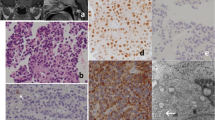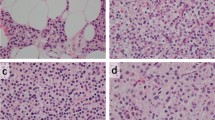Abstract
Retinoid-X receptors (RXRs) are transcriptional factors that belong to the steroid/thyroid hormone receptor (TR) superfamily. It has been demonstrated that those nuclear receptors act as ligand-activated transcription factors in pituitary cells. To determine whether RXRs play roles in the cell differentiation of pituitary adenomas, we have investigated the expression of RXRγ mRNA in various types of pituitary adenomas usingin situ reverse transcriptase-polymerase chain reaction (RT-PCR). The synergistic function on promoters of specific hormones between these nuclear receptors and pituitary specific transcription factor, Pit-1, has been noticed in in vitro experiments. The colocalization between RXRγ mRNA and Pit-1 protein was examined by combinedin situ RT-PCR and immunohistochemistry. RXRγ mRNA was detected in normal pituitary gland as well as all five growth hormone-(GH)-secreting adenomas and five thyroid stimulating hormone (TSH) secreting adenomas, two of four prolactin- (PRL) secreting adenomas, one of two adrenocorticotropin-(ACTH) secreting adenomas, one of four nonfunctioning adenomas. Byin situ hybridization andin situ RT-PCR followed by immunohistochemistry, the colocalization of Pit-1 mRNA with RXRγ as well as RXRγ mRNA with Pit-1 was observed in adenoma cells of GH-secreting adenomas and TSH-secreting adenomas. We suggest that RXRγ may play a role in cell differentiation and hormonal transcription synergistically with Pit-1 in normal and neoplastic human pituitaries.
Similar content being viewed by others
References
Mangeldorf DJ, Ong ES, Dyck JA, Evans RM. Nuclear receptor that identifies a novel retinoic acid response pathway. Nature 345:224–229, 1990.
Yu VC, Delsert C, Andersen B, Holloway JM, Devary OV, Naar AM, Kim SY, Boutin JM. RXRβ: a coregulator that enhances binding of retinoic acid, thyroid hormone and vitamin D receptors to their cognate response elements. Cell 67:1251–1266, 1991.
Leid M, Kastner P, Lyons R. Purification, cloning, and RXR identity of the HeLa cell factor with which RAR or TR heterodimerizes to bind target sequences efficiently. Cell 68:377–395, 1992.
Kliewer SA, Umesono K, Mangelsdorf DJ, Evans RM. Retinoid X receptor interacts with nuclear receptors in retinoic acid, thyroid hormone and vitamin D3 signaling. Nature 355: 446–449, 1992.
Zhang X-K, Hoffmann B, Tran PB-V, Graupner G, Pfahl M. Retinoid X receptor is an auxiliary protein for thyroid hormone and retinoic acid receptors. Nature 355:441–446, 1992.
Mangelsdorf DJ, Borgmeyer U, Heyman RA, Zhou JY, Ong ES, Oro AE, et al. Characterization of three RXR genes that mediate the action of 9-cis retinoic acid. Genes Dev 6:329–344, 1992.
Allenby G, Bocquel MT, Saunders M, et al. Retinoic acid receptors and retinoid X receptors: interactions with endogenous retinoic acids. Proc Natl Acad Sci USA 90:30–34, 1993.
Davis KD, Berrodin TJ, Stelmach JE, Winkler JD, Lazar MA. Endogenous retinoid X receptors can function as hormone receptors in pituitary cells. Mol Cel Biol 14:7105–7110, 1994.
Lala DS, Mukherjee R, Schulman M. Activation of specific RXR heterodimers by an antagonist of RXR homodimers. Nature 383:450–453, 1996.
Levine AA, Sturzenbecker LJ, Kazmer S, Bosalowski T, Huselton C, Allenby G, et al. 9-Cis retinoic acid stereoisomer binds and activates the nuclear receptor RXRα. Nature 355:359–361, 1992.
Sugawara A, Yen PM, Chin WW. 9-cis retinoic acid regulation of rat growth hormone gene expression: potential roles of multiple nuclear hormone receptors. Endocrinol 135:1956–1962, 1994.
Sugawara A, Yen PM, Darling DS, Chin WW. Characterization and tissue expression of multiple triiodothyronine receptor-auxiliary proteins and their relationship to the retinoid X-receptors. Endocrinology 133:965–971, 1993.
Sugawara A, Yen PM, Qi Y, Lechan RM, Chin WW. Isoform-specific retinoid-X receptor (RXR) antibodies detect differential expression of RXR proteins in the pituitary gland. Endocrinology 136:1766–1774, 1995.
Sanno N, Sugawara A, Teramoto A, Abe Y, Yen PM, Chin WW, et al. Immunohistochemical expression of retinoid X receptor isoforms in human pituitaries and pituitary adenomas. Neuro-endocrinology 65:299–306, 1997.
Bodner M, Castrillo J-L, Theill LE, Deerinck T, Ellisman M, Karin M. The pituitary-specific transcription factor GHF-1 is a homeobox-containing protein. Cell 55:505–518, 1988.
Ingraham HA, Chen R, Mangalam HJ. A tissue-specific transcription factor containing a homeodomain specifies a pituitary phenotype. Cell 55:519–529, 1988.
Rhodes SJ, Chen R, DiMattia GE, Scully KM, Kalla KA, Lin SC, et al. A tissue-specific enhancer confers P1T-1 dependent morphogen inducibility and autoregulation on the PIT-1 gene. Genes Dev 7:913–932, 1993.
Steinfelder HJ, Rodovick S, Meoyuski MA. Role of a pituitary specific transcription factor (Pit-1/GHF-1) or a closely related protein in cAMP regulation of human thyrotropin-beta subunit gene expression. J Clin Invest 89:409–419, 1992.
Schaufele F, West BL, Baxter JD. Synergistic activation of the rat growth hormone promoter by Pit-1 and the thyroid hormone receptor. Mol Endocrinol 6:656–665, 1992.
Sanchez-Pacheco A, Palomino T, Aranda A. Retinoid acid induces expression of the transcription factor GHF-1/Pit-1 in pituitary prolactin-and growth hormone-producing cell lines. Endocrinology 136:5391–5398, 1995.
Day RN, Koike S, Sakai M, Muramatsu M, Maurer RA. Both Pit-1 and the estrogen receptor are required for estrogen responsiveness of the rat prolactin gene. Mol Endocrinol 4:1964–1971, 1990.
Lloyd RV, Jin L, Chandler WF. Pituitary specific transcription factor messenger ribonucleic expression in adenomatous and nontumorous human pituitary tissues. Lab Invest 69:570–575, 1993.
Sanno N, Teramoto A, Matsuno A, Itoh J, Takekoshi S, Osamura RY.In situ hybridization analysis of Pit-1 mRNA and hormonal production in human pituitary adenomas. Acta Neuropathol 91:263–268, 1996.
Jin L, Qian X, Lloyd RV. Comparison of mRNA expression detected byin situ PCR andin situ hybridization in endocrine cells. Cell Vision 2:314–321, 1995.
Sanno N, Teramoto A, Matsuno A, Takekoshi S, Itoh J, Osamura RY. Expression of Pit-1 and estrogen receptor messenger ribonucleic acids in prolactin producing pituitary adenomas: non-radioisotopicin situ hybridization analysis. Mod Pathol 9:526–533, 1996.
Sanno N, Jin L, Oian X, Osamura RY, Scheithauer BW, Kovacs K, et al. Gonadotropin releasing hormone mRNA and gonadotropin releasing hormone receptor mRNA expression in pituitaries and pituitary adenomas. J Clin Endocrinol Metab 82:1974–1982, 1997.
Sanno N, Teramoto A, Osamura RY, Genka S, Katakami H, Jin L, et al. A growth hormone-releasing hormone-producing pancreatic islet cell tumor metastasized to the pituitary is associated with pituitary somatotroph hyperplasia and acromegaly. J Clin Endocrinol Metab 82:2731–2737, 1997.
Liu Q, Linney E. The mouse retinoid-X receptor g gene: genomic organization and evidence for functional isoforms. Mol Endocrinol 7:651–658, 1993.
Garcia-Villalba P, Au-Fliegner M, Samuel HH, Aranda A. Interaction of thyroid hormone and retinoic acid receptors on the regulation of the rat growth gene promoter. Biochem Biophys Res Comun 191:580–586, 1993.
Guiguere V. Retinoic acid receptors and cellular retinoid binding proteins: complex interplay in retinoid signaling. Endocr Rev 15:61–79, 1994.
Yen PM, Sugawara A, Chin WW. Triiodothyronine (T3) differentially affects T3-receptor/ retinoic acid receptor and T3-receptor/retinoid X receptor heterodimer binding to DNA. J Biol Chem 267:23,248–23,252, 1992.
Keller H, Givel F, Perroud M, Wahli W. Signaling cross-talk between peroxisome proliferator-activated receptor/retinoid X receptor and estrogen receptor through estrogen response elements. Mol Endocrinol 9:794–804, 1995.
Djakoure C, Guibourdenche J, Porquet D, Pagesy P, Peillon F, Li JY, et al. Vitamin A and retinoic acid stimulate within minutes cAMP release and growth hormone secretion in human pituitary cells. J Clin Endocrinol Metab 81:3123–3125, 1996.
Perez P, Shonthal A, Aranda A. Repression of c-fos gene expression by thyroid hormone and retinoic acid receptors. J Biol Chem 268:23,538–23,543, 1993.
Chuang FM, West BL, Baxter JD, Schaufele F. Activities in Pit-1 determine whether receptor interacting protein 140 activates or inhibits Pit-1/nuclear receptor transcriptional synergy. Mol Endocrinol 11:1332–1341, 1997.
Author information
Authors and Affiliations
Corresponding author
Rights and permissions
About this article
Cite this article
Sanno, N., Sugawara, A., Tahara, S. et al. Retinoid X receptors (RXRs) mRNA expression in human pituitary adenomas. Endocr Pathol 10, 73–83 (1999). https://doi.org/10.1007/BF02738818
Issue Date:
DOI: https://doi.org/10.1007/BF02738818




